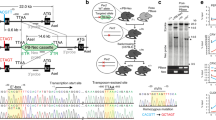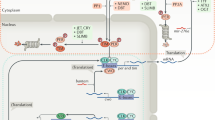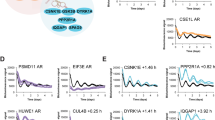Abstract
The circadian rhythms in mammals are regulated by a pacemaker located in the suprachiasmatic nucleus of the hypothalamus1,2. Four clock-gene families have been found to be involved in a transcription–translation feedback loop that generates the circadian rhythm at the intracellular level3. The proteins Clock and Bmal1 form a heterodimer which activates the transcription of the Per gene from the E-box elements in its promoter region4,5. Protein products of Per act together with Cry proteins to inhibit Per transcription6,7, thus closing the autoregulatory feedback loop. We found that Dec1 and Dec2, basic helix–loop–helix transcription factors, repressed Clock/Bmal1-induced transactivation of the mouse Per1 promoter through direct protein–protein interactions with Bmal1 and/or competition for E-box elements. Dec1 and Dec2 are expressed in the suprachiasmic nucleus in a circadian fashion, with a peak in the subjective day. A brief light pulse induced Dec1 but not Dec2 expression in the suprachiasmic nucleus in a phase-dependent manner. Dec1 and Dec2 are regulators of the mammalian molecular clock, and form a fifth clock-gene family.
This is a preview of subscription content, access via your institution
Access options
Subscribe to this journal
Receive 51 print issues and online access
$199.00 per year
only $3.90 per issue
Buy this article
- Purchase on Springer Link
- Instant access to full article PDF
Prices may be subject to local taxes which are calculated during checkout




Similar content being viewed by others
References
Moore, R. Y. & Eichler, V. B. Loss of a circadian adrenal corticosterone rhythm following suprachiasmatic lesions in the rat. Brain Res. 42, 201–206 (1972)
Stephan, F. & Zucker, I. Circadian rhythms in drinking behavior and locomotor activity are eliminated by suprachiasmatic lesions. Proc. Natl Acad. Sci. USA 54, 1521–1527 (1972)
Reppert, S. M. & Wever, D. R. Molecular analysis of mammalian circadian rhythms. Annu. Rev. Physiol. 63, 647–676 (2001)
Gekakis, N. et al. Role of the CLOCK protein in the mammalian circadian mechanism. Science 280, 1564–1569 (1998)
Darlington, T. K. et al. Closing the circadian loop: CLOCK-induced transcription of its own inhibitors per and tim. Science 280, 1599–1600 (1998)
Kume, K. et al. mCRY1 and mCRY2 are essential components of the negative limb of the circadian clock feedback loop. Cell 98, 193–205 (1999)
Yagita, K. et al. Dimerization and nuclear entry of mPER proteins in mammalian cells. Gene Dev. 14, 1353–1363 (2000)
Dunlap, J. C. Molecular bases for circadian clocks. Cell 96, 271–290 (1999)
Shearman, L. P. et al. Interacting molecular loops in the mammalian circadian clock. Science 288, 1013–1019 (2000)
Yu, W., Nomura, M. & Ikeda, M. Interacting feedback loop within the mammalian clock: BMAL1 is negatively autoregulated and upregulated by CRY1, CRY2, and PER2. Biochem. Biophys. Res. Commun. 290, 933–941 (2002)
Shen, M. et al. Molecular characterization of the novel basic helix-loop-helix protein DEC1 expressed in differentiated human embryo chondrocytes. Biochem. Biophys. Res. Commun. 236, 294–298 (1997)
Boudjelal, M. et al. Overexpression of Stra 13, a novel retinoic acid-inducible gene of the basic helix-loop-helix family, inhibits mesodermal and promotes neuronal differentiation of P19 cells. Gene Dev. 11, 2052–2065 (1997)
Rossner, M. J. et al. SHARPs: mammalian enhancer-of-split- and hairy-related proteins coupled to neuronal stimulation. Mol. Cell. Neurosci. 9, 460–475 (1997)
Fujimoto, K. et al. Molecular cloning and characterization of DEC2, a new member of basic helix-loop-helix proteins. Biochem. Biophys. Res. Commun. 280, 164–171 (2001)
Teramoto, M. et al. Gene structure and chromosomal location of a human bHLH transcriptional factor DEC1·Stra13·SHARP-2/BHLHB2. J. Biochem. (Tokyo) 129, 391–396 (2001)
Dear, T. N. et al. Identification of interaction partners for the basic-helix-loop-helix protein E47. Oncogene 14, 891–898 (1997)
Kallio, P. J. et al. Regulation of the hypoxia-inducible transcription factor 1α by the ubiquitin-proteasome pathway. J. Biol. Chem. 274, 6519–6525 (1999)
Mitsui, S. et al. Antagonistic role of E4BP4 and PAR proteins in the circadian oscillatory mechanism. Genes Dev. 15, 995–1006 (2001)
Moore, R. Y. & Card, J. P. Visual pathways and the entrainment of circadian rhythms. Ann. NY Acad. Sci. 453, 123–133 (1985)
Honma, K., Honma, S. & Hiroshige, T. Response curve, free-running period, and activity time in circadian locomotor rhythm of rats. Jpn J. Physiol. 35, 643–658 (1985)
Honma, S. et al. Circadian oscillation of BMAL1, a partner of a mammalian clock gene Clock in rat suprachiasmatic nucleus. Biochem. Biophys. Res. Commun. 250, 83–87 (1998)
Masubuchi, S. et al. Clock genes outside the suprachiasmatic nucleus involved in manifestation of locomotor activity rhythm in rats. Eur. J. Neurosci. 12, 4206–4214 (2000)
Yamazaki, S. et al. Resetting central and peripheral circadian oscillators in transgenic rats. Science 288, 682–685 (2000)
Panda, S. et al. Coordinated transcription of key pathways in the mouse by the circadian clock. Cell 109, 307–320 (2002)
Shigeyoshi, Y. et al. Light-induced resetting of a mammalian circadian clock is associated with rapid induction of the mPer1 transcript. Cell 91, 1043–1053 (1997)
Zylka, M. J., Shearman, L. P., Weaver, D. R. & Reppert, S. M. Three period homologs in mammals: different light responses in the suprachiasmatic circadian clock and oscillating transcripts outside of brain. Neuron 20, 1103–1110 (1998)
Travnickova-Bendova, Z., Cermakian, N., Reppert, S. M. & Sassone-Corsi, P. Bimodal regulation of mPeriod promoters by CREB-dependent signaling and CLOCK/BMAL1 activity. Proc. Natl Acad. Sci. USA 99, 7728–7733 (2002)
Hida, A. et al. The human and mouse Period 1 genes: five well-conserved E-boxes additively contribute the enhancement of mPer1 transcription. Genomics 65, 224–233 (2000)
Sueyoshi, T. et al. The repressed nuclear receptor CAR responds to phenobarbital in activating the human CYP2B6 gene. J. Biol. Chem. 274, 6043–6046 (1999)
Acknowledgements
This work was supported in part by Grants-in-Aid for Scientific Research and Special Coordination Funds for Promoting Science and Technology from the Ministry of Education, Culture, Sports, Science and Technology, the Japanese Government.
Author information
Authors and Affiliations
Corresponding author
Ethics declarations
Competing interests
The authors declare that they have no competing financial interests.
Rights and permissions
About this article
Cite this article
Honma, S., Kawamoto, T., Takagi, Y. et al. Dec1 and Dec2 are regulators of the mammalian molecular clock. Nature 419, 841–844 (2002). https://doi.org/10.1038/nature01123
Received:
Accepted:
Issue Date:
DOI: https://doi.org/10.1038/nature01123
This article is cited by
-
The urothelial gene regulatory network: understanding biology to improve bladder cancer management
Oncogene (2024)
-
BHLHE40/41 regulate microglia and peripheral macrophage responses associated with Alzheimer’s disease and other disorders of lipid-rich tissues
Nature Communications (2024)
-
Identification of the Relationship Between DNA Methylation of Circadian Rhythm Genes and Obesity
Biochemical Genetics (2024)
-
Knockdown of DEC2 expression inhibits the proliferation of mesangial cells through suppressed glycolysis and p38 MAPK/Erk pathway in lupus nephritis
Molecular Medicine (2023)
-
SCFβTrCP-mediated degradation of SHARP1 in triple-negative breast cancer
Cell Death & Disease (2023)
Comments
By submitting a comment you agree to abide by our Terms and Community Guidelines. If you find something abusive or that does not comply with our terms or guidelines please flag it as inappropriate.



